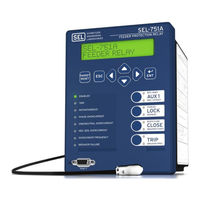
Sel 751A Manuals
Manuals and User Guides for Sel 751A. We have 1 Sel 751A manual available for free PDF download: Instruction Manual
Sel 751A Instruction Manual (641 pages)
Feeder Protection Relay
Table of Contents
-
Preface
19-
Conventions20
-
Overview27
-
Features27
-
-
-
Accessories30
-
Applications31
-
-
-
Overview41
-
-
-
-
I/O Diagram59
-
Serial Ports57
-
-
-
-
Overview77
-
Setup78
-
Settings82
-
-
Text Files87
-
-
Get Event88
-
-
-
Relay Word Bit108
-
-
RTD Location119
-
RTD Type120
-
-
-
Voltage Window129
-
Power Elements134
-
Setting SYNCPH127
-
-
Trip/Close Logic142
-
-
-
Reclose Logic151
-
-
-
Reset Timer156
-
Setting 79RSD157
-
Setting 79RSLD157
-
Lockout State153
-
-
Demand Metering168
-
-
Latch Bits173
-
SELOGIC Enables173
-
Power Loss175
-
Settings Change175
-
-
Analog Inputs192
-
Analog Outputs195
-
Breaker Monitor197
-
Data Reset199
-
Access Control199
-
-
Local Bits211
-
Pushbutton Leds213
-
-
Overview219
-
Metering220
-
Thermal Metering222
-
Energy Metering223
-
Load Profiling229
-
-
Breaker Monitor233
-
-
Via Front Panel242
-
Via Serial Port242
-
-
-
Overview245
-
-
View Settings248
-
Enter Settings248
-
-
-
-
Identifier251
-
Undervoltage258
-
Overvoltage259
-
Power Factor260
-
Frequency260
-
Power262
-
Sv/Timers265
-
Math Variables272
-
Base Output273
-
Slot C Output274
-
Slot D Output274
-
Slot E Output274
-
Breaker Failure279
-
Modbus292
-
DNP3 Protocol292
-
Analog Input Map314
-
-
-
Overview319
-
-
Failover Mode323
-
-
-
Message Format331
-
Ping Server331
-
Telnet Server331
-
Access Levels333
-
Command Summary334
-
-
-
CEV Command340
-
HELP Command347
-
LOOPBACK Command349
-
PULSE Command353
-
-
-
Overview361
-
Contrast362
-
Meter Menu365
-
Lamp Test373
-
Event Reporting377
-
-
-
Overview377
-
Length378
-
Triggering378
-
Event Reporting378
-
Event Summaries379
-
Event History381
-
Event Reports382
-
-
-
SER Triggering391
-
SER Aliases391
-
-
Testing Tools393
-
-
-
Overview393
-
-
Relay Self-Tests404
-
-
-
-
Demand Data433
-
-
-
Overview435
-
-
Data Handling436
-
Objects436
-
-
Data Access440
-
-
Event Data442
-
Binary Controls443
-
-
Modem Support444
-
-
Binary Inputs461
-
Binary Outputs461
-
-
-
-
Overview463
-
-
-
Features545
-
-
Object Models547
-
Data Mapping548
-
Mms548
-
Goose548
-
-
File Services549
-
SCL Files549
-
Reports549
-
-
Logical Nodes562
-
Devicenet Card581
-
-
-
-
Glossary
623 -
Index
629
Advertisement
Advertisement
